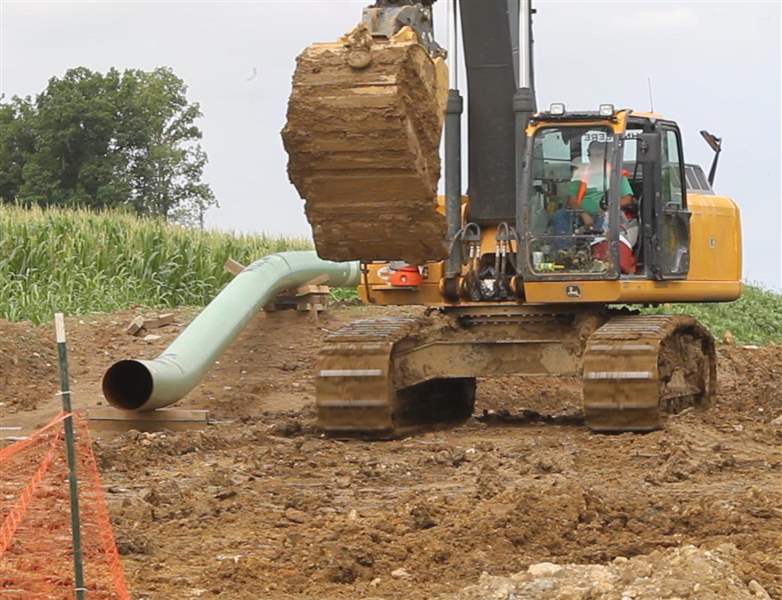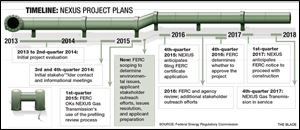
NEXUS PROJECT
Federal agency to hold meetings about pipeline
4/21/2015

They’re called federal scoping meetings.
But really, what the federal government — in this case, the Federal Energy Regulatory Commission — tries to do by hosting such events is gauge what area property owners view as safety and environmental issues about major construction projects, such as the 250-mile pipeline that NEXUS Gas Transmission wants to build across 11 northern Ohio counties and three in southeastern Michigan.
If approved, the company, a subsidiary of Houston-based Spectra Energy, would link existing structures to enable natural gas from southeast Ohio and southwest Pennsylvania to be pumped for decades into Canada via Michigan to a hub south of Sarnia, Ont., starting in late 2017.
The agency will host six scoping meetings about the NEXUS project starting April 28, each starting at 6 p.m. The three closest to Toledo will be May 5 at Tecumseh Center for the Arts, 400 N. Maumee St., Tecumseh, Mich.; May 6 at Swanton High School, 601 N. Main St., Swanton, and May 7 at Fremont Ross High School, 1100 North St., Fremont. The first three are in Grafton, Wadsworth, and Louisville, Ohio.
Several northwest Ohio residents said they plan to call the agency’s attention to parts of the proposed pipeline route that pass through the globally rare Oak Openings region and part of the Maumee State Forest, the only state forest in northwest Ohio.

One is Walt Lange, a retired mathematician and resident of Fulton County’s Swancreek Township who fears the pipeline company “literally would make a strip mine” out of Oak Openings and the state forest.
“The whole thing is not logical,” Mr. Lange said.
He and his wife, Donna, a former corporate secretary, own the 32-acre Lange Tree Farm that is nestled inside the Oak Openings region. In 2010, they were named Ohio Tree Farmers of the Year by a state panel supported by the Ohio Forestry Association and the Ohio Department of Natural Resources.
To Mr. Lange, the Oak Openings — a region where oak savannas and tall prairie grasses once met — is as ecologically important as the Florida Everglades.
Scientists have said Oak Openings has more globally rare plants, including wild lupine, than any other region in Ohio. Its greatest wildlife symbol, the Karner blue butterfly, is the nation’s first endangered butterfly to successfully be reintroduced to an area from which it had vanished. The Oak Openings region also has more nesting songbirds than any other part of Ohio, including Ottawa County’s famed marshes.
The U.S. Environmental Protection Agency states on its website that Oak Openings “has persisted as one of the few landscape scale oak savanna/prairie complexes left in the Midwest.”
Arthur Diestel, a NEXUS spokesman, said it’s important for people to realize the route has not been finalized, with a formal plan submission to FERC scheduled for fall.
“NEXUS is currently conducting survey activities in order to fully understand the study corridor’s attributes and to determine the location for the pipeline that minimizes impacts on landowners and the environment,” he said.
A series of study corridors have been established along the potential route to help the company determine if it needs to be rerouted, he said.
The project is still “in the development stage,” with surveying along a 600-foot-wide corridor, Mr. Diestel said.
“Once field evaluations are completed, the pipeline corridor will be reduced to a much narrower width, which would be required to construct the pipeline,” he said.
Several Ohio property owners between Medina and Fulton counties belong to a grassroots group called CORN, which stands for Coalition to Reroute NEXUS, formerly called NAN, which stood for Neighbors Against NEXUS.
NEXUS is one of at least three major pipeline projects planned for northwest Ohio in coming years.
Energy Transfer Partner LP’s $4.3 billion Rover Pipeline would be an 823-mile conduit running from southeast Ohio west to Defiance County, then north to Michigan and Canada. The 409-mile main line will have nine new lateral pipelines ranging from 4 to 206 miles to connect it to southeast Ohio, Michigan, and Canada.
Kinder Morgan has announced plans to build two new pipeline systems through its Utopia East and Utopia West projects and have them connect to an existing pipeline and facilities. Both would be 12 inches in diameter and transport various fuel products.
All the projects are driven by a natural-gas drilling boom in eastern Ohio supported by a technique for hydraulic fracturing — also called fracking — gas-laden shale that was previously inaccessible.
That growth has led to a groundswell of activism, as well as lawyers offering their services.
One of them, Michael Braunstein, of Goldman & Braunstein LLP in Columbus, told The Blade after meeting with 50 residents in Fremont on April 15 he believes a high percentage of landowners — probably 70 percent — usually accept a pipeline company’s initial offer, while the rest hire lawyers.
Mr. Braunstein’s basic advice to those in the audience was to not sign anything — especially easement rights — before first consulting an attorney, whether it’s someone in his firm or another one. Once a landowner signs a right-of-way easement, negotiating compensation for losses becomes harder, he said.
Pipeline companies should be willing to pay for insurance and all damages unique to one’s property, from any water pollution to livestock losses in event of a leak or explosion. In many cases, pipelines should be laid near fences instead of across the middle of land, he said.
Landowners should look for lawyers who specialize in eminent domain, the proceeding under which pipeline companies may seize rights of way when landowners balk at signing easements, said Mr. Braunstein, who has specialized in that area for 20 years.
“The recent development of Ohio’s shale-gas deposits has spawned thousands of miles of pipelines to carry the gas produced by shale fracking. It has also spawned thousands of conflicts between the pipeline companies and the landowners in their way,” according to comments his law firm filed March 20 with FERC. “Without representative intervention early in the FERC process, Ohio landowners face permanent and irreparable harm.”
Terry Lodge, a Toledo attorney working with activist groups, said the simple advice of getting a lawyer needs to be examined too, because that’s “built on the perception that there’s nothing that can be done to stop an inevitable pipeline.
“That sweeping concession locks down the route and commits the project to be completed,” Mr. Lodge said.
Paul Wohlfarth, a CORN member, said the group has advised landowners along the route to hold off on legal advice for the time being.
“FERC has not approved this project, so until the NEXUS project is approved it is illegal to bully landowners into signing leases,” Mr. Wohlfarth said.
Contact Tom Henry at: thenry@theblade.com, 419-724-6079, or via Twitter @ecowriterohio.